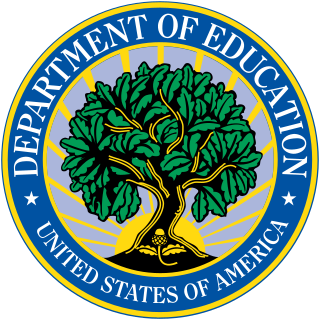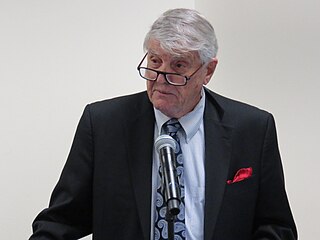Education reform is the name given to the goal of changing public education. The meaning and education methods have changed through debates over what content or experiences result in an educated individual or an educated society. Historically, the motivations for reform have not reflected the current needs of society. A consistent theme of reform includes the idea that large systematic changes to educational standards will produce social returns in citizens' health, wealth, and well-being.

The United States Department of Education is a Cabinet-level department of the United States government. It began operating on May 4, 1980, having been created after the Department of Health, Education, and Welfare was split into the Department of Education and the Department of Health and Human Services by the Department of Education Organization Act, which President Jimmy Carter signed into law on October 17, 1979.
K–12, from kindergarten to 12th grade, is an English language expression that indicates the range of years of publicly supported primary and secondary education found in the United States and Canada, which is similar to publicly supported school grades before tertiary education in several other countries, such as Afghanistan, Australia, Canada, China, Ecuador, Egypt, India, Iran, the Philippines, South Korea, and Turkey. K–12 refers to the American system which affords authority to local intersectional "districts" which may be specific to a municipality, county, or several regions, depending on population and proximity.

Susan Carol Davis is a former American politician who served as the U.S. representative for California's 49th congressional district for one term and California's 53rd congressional district for nine terms from 2001 to 2021. She is a member of the Democratic Party.

John Paul Kline Jr. is an American politician who served as a member of the United States House of Representatives from Minnesota's 2nd congressional district from 2003 to 2017. The district included most of the southern suburbs of the Twin Cities. A member of the Republican Party, Kline served as the Chairman of the House Committee on Education and the Workforce from 2011 until 2017. Kline retired from Congress at the end of his term in January of 2017.
The Women's Educational Equity Act (WEEA) of 1974 is one of the several landmark laws passed by the United States Congress outlining federal protections against the gender discrimination of women in education. WEEA was enacted as Section 513 of P.L. 93-380. Introduced in the United States House of Representatives by Congresswoman Patsy Mink of Hawaiʻi, the legislation was conceived and drafted by Arlene Horowitz, a staff assistant to the education subcommittee on which Mink served. WEEA was intended to combat sex-role stereotyping in elementary and secondary schools.

The Elementary and Secondary Education Act (ESEA) was passed by the 89th United States Congress and signed into law by President Lyndon B. Johnson on April 11, 1965. Part of Johnson's "War on Poverty", the act has been one of the most far-reaching pieces of federal legislation affecting education ever passed by the United States Congress, and was further emphasized and reinvented by its modern, revised No Child Left Behind Act.

The Committee on Education and the Workforce is a standing committee of the United States House of Representatives. There are 50 members of this committee. Since 2023, the chair of the Education and the Workforce committee is Virginia Foxx of North Carolina.
ISD 279-Osseo Area Schools is a school system in Hennepin County, Minnesota. ISD 279 provides public education from the primary to secondary levels in the following to parts of Brooklyn Center, Brooklyn Park, Maple Grove, Osseo, Plymouth, Corcoran, Dayton and Rogers. District 279 is the fifth largest district in Minnesota, with a student population of approximately 20,900 in 2019.

The ketchup as a vegetable controversy stemmed from proposed regulations of school lunches by the USDA's Food and Nutrition Service (FNS) in 1981, early in the presidency of Ronald Reagan. The regulations were intended to provide meal planning flexibility to local school lunch administrators coping with cuts to the National School Lunch Program enacted by the Omnibus Reconciliation Acts of 1980 and 1981. The proposed changes allowed administrators to meet nutritional requirements by crediting food items not explicitly listed. While ketchup was not mentioned in the original regulations, pickle relish was used as an example of an item that could count as a vegetable.
Title 20 of the United States Code outlines the role of education in the United States Code.
The Strengthening Kids' Interest in Learning and Libraries Act or SKILLS Act is proposed legislation introduced in the United States Congress.
Education in the Northern Mariana Islands is linked to the United States Department of Education as the Northern Mariana Islands form part of the United States Commonwealth. This encompasses the sectors of pre-K, elementary schools, middle schools, high schools and college education. The main governing body in the region is the Commonwealth of the Northern Mariana Islands Public School System whose headquarters are located on Capital Hill, Saipan. Currently, there are 20 schools operating within the CNMI PSS. There are also a number of private and home school systems operating in the region. The educational system follows a similar model to the United States educational system whereby children between the ages of 5-16 are mandated to attend formal school. All educational institutions, systems and budget are governed first by the US Board of Education, followed by the Northern Mariana Islands State Board of Education, which was established in 1988 as a requirement of the Northern Mariana Islands Constitution.

Asian College of Technology, officially the Asian College of Technology - International Educational Foundation, is a private college in the Philippines, located in Cebu City and Talisay City, in the Cebu province.
Susan Neuman is an educator, researcher, and education policy-maker in early childhood and literacy development. In 2013, she became Professor of Early Childhood and Literacy Education, and Chair of the Department of Teaching and Learning at NYU's Steinhardt School of Culture, Education, and Human Development.
The highly qualified teacher provision is one of the goals of the No Child Left Behind Act (NCLB) of 2001. The term highly qualified teachers (HQT) comes from the original language of Title II of the No Child Left Behind Act. Title II of NCLB designates federal funds to educational agencies for the purpose of improving the student achievement through the professional development of highly qualified teachers and principals. To qualify for this funding, states must comply with a series of conditions stipulated in NCLB, and track their progress toward goals each state sets. Title II was originally known as the Eisenhower Professional Development Program, and has undergone several reauthorizations, though the original intent has remained relatively intact. The main goals of the highly qualified teacher provision is to ensure that every classroom is staffed by a teacher deemed "highly qualified" under conditions set by NCLB. As some point out, this section of NCLB is quite at odds with the general thrust of NCLB because it focuses on school inputs rather than student outcomes. The sections of NCLB designated to HQTs allocates the majority of the funds to the states and does not clearly define at the federal level what is and what is not a highly qualified teacher, allowing for more local definitions of this term. This provision has come under much scrutiny, as it is up to states to decide how to measure highly qualified, and states are not holding their teachers to the same level of rigor across the country. Since its reauthorization in 2001, Title II has yet to reach its stated goal of ensuring that 100% of teachers in public schools in the United States are highly qualified.
The 1981 Education Consolidation and Improvement Act (ECIA) reauthorized the Elementary and Secondary Education Act (ESEA), significantly deregulating education in the United States and shifting a number of responsibilities back to the state level. As part of the Reagan administration’s Omnibus Reconciliation Act of 1981, this act curtailed federal intervention and funding for domestic social causes while expanding the role of state and local government in administering education. This deregulation is symbolized by the reduced size of Title I, which was reduced from 75 pages to just 14.

Edwin W. Martin Jr. is a policymaker in the area of education for people with disabilities. He served as congressional committee staff and in the Johnson, Nixon, Ford and Carter administrations. He was instrumental in drafting the Education of All Handicapped Children Act (1975). When the Department of Education was created in 1979–1980, Martin served as the first Assistant Secretary of Education for Special Education and Rehabilitative Services.
Early childhood education in the United States relates to the teaching of children from birth up to the age of eight. The education services are delivered via preschools and kindergartens.
The federal government of the United States has limited authority to act on education, and education policy serves to support the education systems of state and local governments through funding and regulation of elementary, secondary, and post-secondary education. The Department of Education serves as the primary government organization responsible for enacting federal education policy in the United States.







